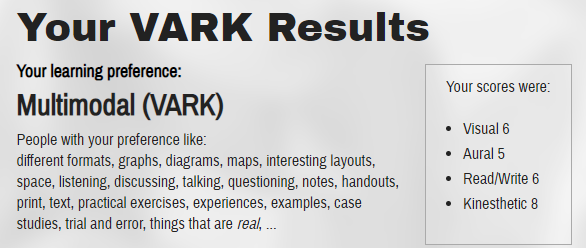In a paper 750‐1,000 words, summarize your analysis of this exercise and discuss the overall value of learning styles. Include the following: Provide a summary of your learning style according the VARK questionnaire. Describe your preferred learning strategies. Compare your current preferred learning strategies to the identified strategies for your preferred learning style. Describe how individual learning styles affect the degree to which a learner can understand or perform educational activities. Discuss the importance of an educator identifying individual learning styles and preferences when working with learners. Discuss why understanding the learning styles of individuals participating in health promotion is important to achieving the desired outcome. How do learning styles ultimately affect the possibility for a behavioral change? How would different learning styles be accommodated in health promotion?
My Learning Style
The ability of people to acquire knowledge differs across different personalities and environments. The learning styles and techniques of someone may be a combination of different styles that could be applied over a wide range of circumstances (Truong, 2016). Regardless of one’s physical presentation, it is necessary to learn that they can develop specific styles of learning in response to present needs. In most schools, the curriculum employed allows learners to use their styles of choice including book-based learning, tutorials, class discussions, as well as exams. Recognizing one’s own learning styles improves the speed and the quality of learning they experience in different environments.
Summary of My Learning Style According to the VARK Questionnaire
According to the VARK questionnaire, my learning preference is Multimodal, whereby I prefer learning concepts using multiple methods or channels of communication. Among these different ways, my largest preference is Kinesthetic, as I had the highest scores in the category. Kinesthetic learning implies that I prefer using my hands, body, and sense of touch when learning. From the results, it is clear that people with my preference like to use different formats of information such as maps, graphs, and diagrams (Truong, 2016). They also like using discussions, listening, questioning, and taking notes, practical exercises, as well as experiences. Most importantly, they like using things that are real such as case studies in understanding various concepts that boost their learning experience.

Fig 1. A screenshot of my scores from the VARK website. My preferred mode of learning is multimodal, with kinesthetic being the highest choice (The VARK Questionnaire, 2019).
My Preferred Learning Strategies
Among the strategies I prefer in learning include class discussions as well as class lectures that have illustrative diagrams. This relates to my learning style as it is a connection of different styles to achieve one mixture of methods. The main reason why I prefer class discussions is because they allow one to express themselves to class colleagues (and other people horizontally- with common level of education) about their learning experience. Illustrative diagrams also allow one to grasp the concept without much difficulty.
How Learning Styles Can Affect the Degree of Performance in Educational Activities
Learning styles affect the degree of performance in educational activities in that the better the learning style, the greater the performance. People who have not learnt how to integrate their learning styles with the educational activities find it hard improving the performance in the learning forums that they are involved in (Willingham, Hughes, & Dobolyi, 2015). When working with learners, educators should investigate their individual learning styles as they would understand the most applicable techniques when imparting them with knowledge, and this can greatly improve the learning outcomes.
Why Understanding the Learning Styles of Individuals Involved in Health Promotion is Important
Health promotion is a marketing strategy in which marketers or members of healthcare units attempt to increase the likelihood of health products becoming more popular among members of the public (Bokhari & Zafar, 2019). Just like teachers and lecturers, individuals participating in such campaign have the goal of increasing the knowledge of various products in a positive way to the members of the public.
They can achieve the results through implementing practices and lessons that directly or indirectly result to behavior change and subsequent demand of the health products.
Learning styles of the recipients of health promotional material can affect behavior change in that the more the promoter is aware of the recipient’s learning style, the higher the likelihood of changing their behavior (Bokhari & Zafar, 2019). People with a greater coincidence of learning styles knowledge have a higher likelihood of achieving positive results.
Behavior change is also accomplished more easily when health promoters have the potential to quickly recognize the effect of their techniques on behavior change.
Different learning styles can be accommodated in health promotion by having health promotion experts who have specific specializations of teaching. That is, when a certain group of expert is specialized in educating kinesthetic learners about the product, it becomes easier to convince the clients using their own language (Bokhari & Zafar, 2019
Order this paper